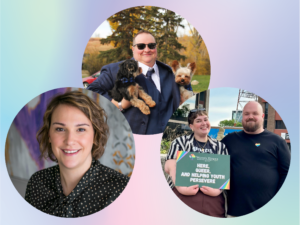By Jamie Large, Wood’s Homes Team Leader
Did you flinch when you read the title of this blog post? I often get the sense from others that the emotional expression of professionals in the workplace is taboo. This intrigues me.
When I ask around, the most common thoughts about this is that there are limitations to staff emotions in the workplace. Wherever, whenever and however emotions are expressed, we have ideas about levels of appropriateness. Pairing labels of ‘limiting’ and ‘appropriateness’ with emotions raises further questions for me.
Emotional flattening seems to be the preference of many professionals. As an expression, we believe flattening gives the professional message of control, neutrality and diplomacy, despite our internals signaling otherwise. It may seem a stretch to connect emotional blunting of ourselves to the work we do, but emotional blunting is also a symptom of vicarious trauma and secondary trauma. As many of my Wood’s Home’s mentors would say, “We have an extremely hard job to do here”.
When we think of professionalism and conduct, there is an expectation of high emotional intelligence (otherwise known as emotional quotient or EQ) amongst helping professionals. EQ is about our ability to be cognizant of and manage emotions as they arise. This translates into an expectation, for both ourselves or others, that our outward responses and reactions to a workplace situation should come from a place of consideration for others.
I think most would agree that we all seek EQ as it relates to transforming emotions, relational health and general self-expansion. However, I think there are flaws in rigidly expecting one’s self and others to continuously be ‘on’ or ‘managing’ our emotions. We forget we have blind-spots and we can fall apart. We all have a threshold for EQ. Have you ever rubbed up against it? Have your ever been in total loss of control with your emotions, especially when they are unexpected?
It is only by experiencing and challenging this threshold that we build capacity to manage our emotions. This is the space that intrigues me. It is in those moments when I ask: How we can support one another and give birth to greater EQ?
When we hold each other to such a ridged idea of what emotional control looks like, then we lose the opportune moments to connect deeper, find comfort and walk the journey together.
Emotionality is psychosomatic, but our psyche can become disconnected from signals of the body. It’s a common experience for most, and a normal one for unprocessed trauma. We often don’t know we have something unprocessed until our body indicates that it is re-experiencing a similar threat. So how can we expect ourselves to be in control of our emotions all the time?
Emotions are connected to our survival, and we don’t always know when our insides are at war with our environment until it happens. We can, however, experience and navigate the surprises within us to master what is outside of us.
The ‘hard’ part of the work we do at Wood’s Homes is navigating the uncharted territories of others’ pain and trauma. Working with unique individuals and families is different from skilled trades – there is no been there, done that. This work comes with new varieties of pain and wounds in each disclosure and emotional share. It is a dynamic relationship we share. This can open our raw place, our humanity, and sacred places for authentic connection.
It’s okay not to be okay.
We don’t know what we don’t know, and this is especially true for our emotional system navigation. My commitment as team member at Wood’s Homes is to create emotionally supportive spaces. If we can’t help ourselves and counsel ourselves, how can we help others navigate raw wounds?
It’s okay to not be okay with me.
Below is a list of resources on emotional processing and building EQ:
- The emotional wheel and rage
- Brain dumping for resolving overwhelm
- 5-4-3-2-1 method for anxiety
- Mental pause button
- Emotional intelligence in the workplace
- Reptilian brain
Eastside Community Mental Health Services offers immediate, no-cost, mental health support from an integrated ethnocultural team. It’s a place you can rely on when you have troubles at home or need someone to talk to. Call 403-299-9699.




